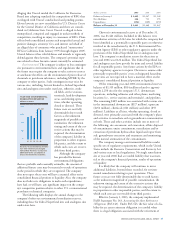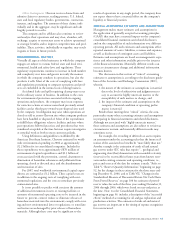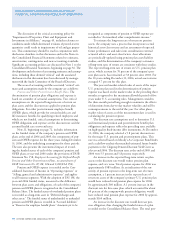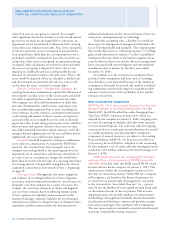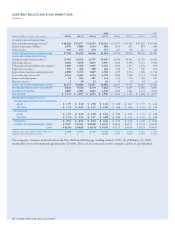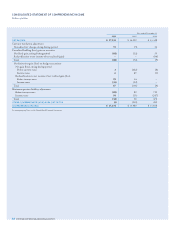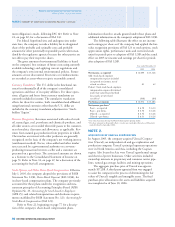Chevron 2006 Annual Report Download - page 52
Download and view the complete annual report
Please find page 52 of the 2006 Chevron annual report below. You can navigate through the pages in the report by either clicking on the pages listed below, or by using the keyword search tool below to find specific information within the annual report.
50 CHEVRON CORPORATION 2006 ANNUAL REPORT50 CHEVRON CORPORATION 2006 ANNUAL REPORT
REPORT OF INDEPENDENT REGISTERED PUBLIC ACCOUNTING FIRM
To the Stockholders and the Board of Directors of Chevron Corporation:
We have completed integrated audits of Chevron Corporation’s
consolidated fi nancial statements and of its internal control over
fi nancial reporting as of December 31, 2006, in accordance with
the standards of the Public Company Accounting Oversight
Board (United States). Our opinions, based on our audits, are
presented below.
CONSOLIDATED FINANCIAL STATEMENTS
In our opinion, the accompanying consolidated balance sheets
and the related consolidated statements of income, compre-
hensive income, shareholders’ equity and cash fl ows present
fairly, in all material respects, the fi nancial position of Chevron
Corporation and its subsidiaries at December 31, 2006, and
December 31, 2005, and the results of their operations and
their cash fl ows for each of the three years in the period ended
December 31, 2006, in conformity with accounting principles
generally accepted in the United States of America. These fi nancial
statements are the responsibility of the Company’s management.
Our responsibility is to express an opinion on these fi nancial
statements based on our audits. We conducted our audits of
these statements in accordance with the standards of the Public
Company Accounting Oversight Board (United States). Those
standards require that we plan and perform the audit to obtain
reasonable assurance about whether the fi nancial statements are
free of material misstatement. An audit of fi nancial statements
includes examining, on a test basis, evidence supporting the
amounts and disclosures in the fi nancial statements, assessing
the accounting principles used and signifi cant estimates made by
management, and evaluating the overall fi nancial statement pre-
sentation. We believe that our audits provide a reasonable basis
for our opinion.
As discussed in Note 14 to the Consolidated Financial
Statements, the Company changed its method of accounting
for buy/sell contracts on April 1, 2006.
As Discussed in Note 21 to the Consolidated Financial
Statements, the Company changed its method of accounting
for defi ned benefi t pension and other postretirement plans on
December 31, 2006.
INTERNAL CONTROL OVER FINANCIAL REPORTING
Also, in our opinion, management’s assessment, included in
the accompanying Management’s Report on Internal Control
Over Financial Reporting, that the Company maintained
effective internal control over fi nancial reporting as of Decem-
ber 31, 2006, based on criteria established in Internal Control
– Integrated Framework issued by the Committee of Sponsor-
ing Organizations of the Treadway Commission (COSO), is
fairly stated, in all material respects, based on those criteria.
Furthermore, in our opinion, the Company maintained, in
all material respects, effective internal control over fi nancial
reporting as of December 31, 2006, based on criteria estab-
lished in Internal Control – Integrated Framework issued by
the COSO. The Company’s management is responsible for
maintaining effective internal control over fi nancial reporting
and for its assessment of the effectiveness of internal control
over fi nancial reporting. Our responsibility is to express opin-
ions on management’s assessment and on the effectiveness of
the Company’s internal control over fi nancial reporting based
on our audit. We conducted our audit of internal control
over fi nancial reporting in accordance with the standards of
the Public Company Accounting Oversight Board (United
States). Those standards require that we plan and perform the
audit to obtain reasonable assurance about whether effective
internal control over fi nancial reporting was maintained in all
material respects. An audit of internal control over fi nancial
reporting includes obtaining an understanding of internal
control over fi nancial reporting, evaluating management’s
assessment, testing and evaluating the design and operating
effectiveness of internal control, and performing such other
procedures as we consider necessary in the circumstances.
We believe that our audit provides a reasonable basis for
our opinions.
A company’s internal control over fi nancial reporting is
a process designed to provide reasonable assurance regard-
ing the reliability of fi nancial reporting and the preparation
of fi nancial statements for external purposes in accordance
with generally accepted accounting principles. A company’s
internal control over fi nancial reporting includes those poli-
cies and procedures that (i) pertain to the maintenance of
records that, in reasonable detail, accurately and fairly refl ect
the transactions and dispositions of the assets of the company;
(ii) provide reasonable assurance that transactions are recorded
as necessary to permit preparation of fi nancial statements in
accordance with generally accepted accounting principles, and
that receipts and expenditures of the company are being made
only in accordance with authorizations of management and
directors of the company; and (iii) provide reasonable assur-
ance regarding prevention or timely detection of unauthorized
acquisition, use, or disposition of the company’s assets that
could have a material effect on the fi nancial statements.
Because of its inherent limitations, internal control over
fi nancial reporting may not prevent or detect misstatements.
Also, projections of any evaluation of effectiveness to future
periods are subject to the risk that controls may become inad-
equate because of changes in conditions, or that the degree of
compliance with the policies or procedures may deteriorate.
San Francisco, California
February 28, 2007



